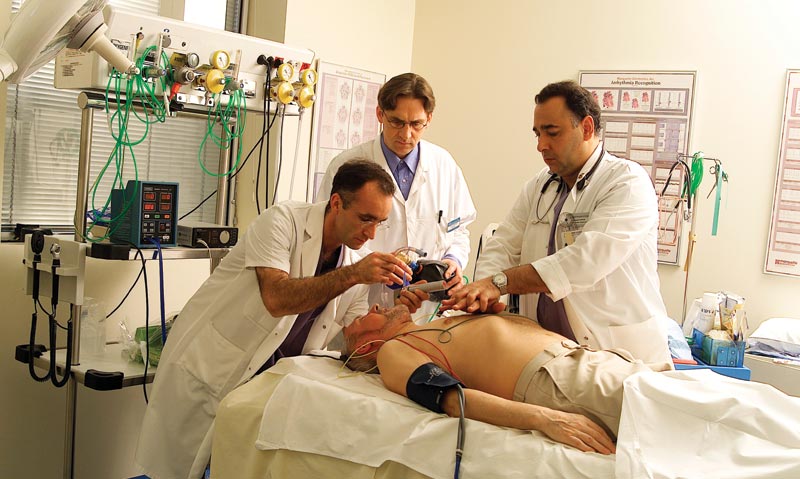RAPID response team callouts within hospitals significantly disrupt the team members’ normal routines, but do not cause any major harms to patients, new research published in the MJA shows. (1)
The research conducted at Concord Hospital in Sydney was instigated after reports of potential adverse events, such as delayed medication dispensing, as a result of staff leaving normal duties to attend medical emergency team (MET) calls.
The authors noted that clinical emergency response systems such as METs, rapid response teams, patient-at-risk teams and critical care outreach teams were used in hospitals worldwide to manage patients with unexpected clinical deterioration. However, the optimal staffing structure for these systems was unknown.
They interviewed the Concord MET members after each callout over a period of 18 weeks, finding callouts resulted in interruptions to ward rounds, patient reviews, handover meetings, patient procedures and outpatient clinics. The team members also reported leaving work late, missing meal breaks, missing an education session and general inconvenience or annoyance.
The researchers found the rate of such incidents was 214 per 1000 MET participant attendances. However, reassuringly, they found no adverse events resulting in patient disability, death or prolonged hospital stay as a result of callouts, which averaged 2.6 per day.
The researchers suggested that to minimise disruption, better cover could be provided for MET members for ward rounds, procedures and clinics, and a further tier could be added to the MET system so that a smaller team could attend middle-tier calls.
Associate Professor Ross Kerridge, conjoint associate professor in the School of Medicine at the University of Newcastle, acknowledged there was significant resentment and resistance among intensive care doctors at some hospitals towards leaving their unit to attend MET calls.
“It would appear that the problem is a cultural one — that doctors and nurses remain acculturated to the traditional hierarchical response system, and see unpredictable calls to intervene, assess and treat a deteriorating patient as an inappropriate impost on their time”, Professor Kerridge, who is also an anaesthetist and director of the perioperative service at the John Hunter Hospital in Newcastle, told MJA InSight.
“Rather than resisting the development of MET/RRS [rapid response systems], we should change our culture, accept it as the normal, and staff our hospitals appropriately”, he said, admitting that changing culture was “notoriously difficult” because “culture eats evidence for breakfast”.
He raised concerns about some large hospitals responding to the frustration of MET members by delegating calls back to the “home team” or the duty medical registrar, and restricting the intensive care and anaesthetic staff to cardiorespiratory arrests.
“Ironically, this appears to focus the attention of skilled staff on patients who may have deteriorated beyond the point of effective intervention”, he said.
Associate Professor Daryl Jones, medical director of Critical Care Outreach at Melbourne’s Austin Hospital, said METs and the intensive care units (ICUs) which typically staffed them were under immense strain as an increasing proportion of hospital inpatients were prone to deterioration.
“The trend towards increasingly earlier discharge means the patients who are actually in hospital tend to be very complex”, he told MJA InSight.
“There is frustration that some hospitals may use METs as a bandaid for … resourcing their wards, and sometimes the parent units can disengage from preventing deterioration in their own patients.”
However, Professor Jones said it remained smarter to have ICU staff “go outside the unit to try to prevent patients coming into ICU, compared with having extra beds in ICU”.
Professor Jones coauthored a “Clinical focus” article in the same issue of the MJA which argues that RRS may reduce deaths by up to one-third and cardiac arrests by up to 50%. (2)
The authors wrote that further work was needed to determine the most at-risk patients, but suggested that systems which encouraged close patient observation were superior to those that focused on “risk scores”.
Professor Jones told MJA InSight that doctors who were frustrated by the disruptions associated with leaving their unit to attend MET calls should conduct research similar to the Concord Hospital study to demonstrate to hospital administrators their need for additional resources.
1. MJA 2014; 201: 528-531
2. MJA 2014; 201: 519-521
(Photo: AJ Photo / Science Photo Library)

 more_vert
more_vert
At a hospital were I worked as a resident, falls and other events were all treated as Code Blue by the administrative staff, on instruction by the Director of Medical Services.
The first time I responded to Code Blue, which was a patient fall in the foyer, I asked the Deputy Director of Medical Services why they had this policy. I never had a satisfactory response, of course. Nor did I attend any other Code Blues in a hurry.
The difficulty, as your author identified, is that there is not enough clinical staff, especially doctors, to cope with routine and emergent work. Too much funding is spent on Human Resources and other administrative staff.
And this goes on to lead to other problems – like the second year resident left in charge of the emergency department for 24 hours at Caloundra Hospital on the 6th of January 2002. While hospital administrators are not held responsible for their actions, none of the problems raised in the article will ever be successfully addressed.